Over time, experienced crocheters will tell you that choosing yarn for crochet can be just as much fun as creating the projects themselves. The different types of fibers, colors, weights and styles of yarn on the market have exploded in recent years, making shopping for yarn a fun part of the creative process. While it’s exciting, the variety can also create issues when trying to make sure you have the right yarn for your project.
How to choose the best yarn for your crochet project? Understanding how to read a yarn label (fiber type, yardage, weight, etc.) and understanding what types of yarn work best for your pattern are the best strategies to choose yarn.
Before we review the details about choosing yarn for crochet, it’s important to note that choosing yarn is just as much about having the knowledge as it is about personal preference. While patterns give guidance, the more you crochet the more you’ll learn about the types and styles of yarn you enjoy working with. As you experiment, it can be helpful to ask another crocheter for tips on working with a particular yarn. Try a project with one yarn, then swap it out for something else and see what you like better. Finally, always start with a gauge swatch, especially if you’ve never worked with yarn before. It will give you a lot of information about the yarn before you begin your project.
How is Yarn Sold?
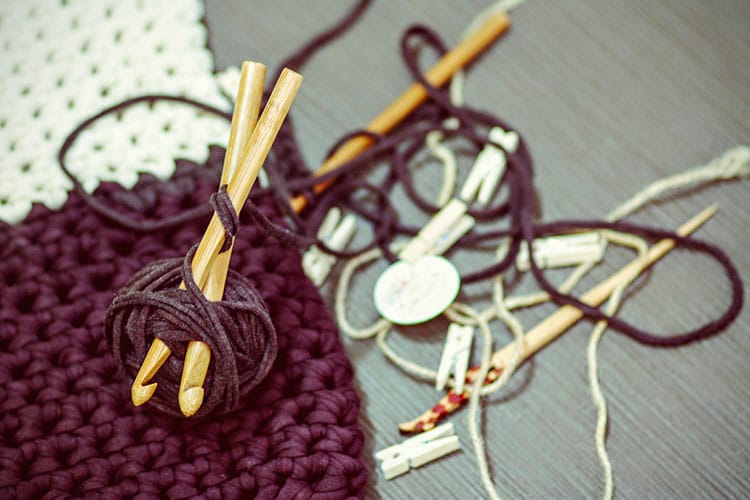
When you head to your local yarn or craft store, you’ll quickly notice that not all yarns are sold in the same shape. Yarns are typically packaged as skeins or hanks, and less commonly as balls.
Skeins – Skeins are the most common way that yarn is sold because they are easy for manufacturers and retailers to stack, store and ship. Skeins are yarn that’s been wrapped into a loose, twisted shape. To crochet a skein of yarn, you simply pull the end out of the center of the skein and begin crocheting.
Hanks – Hanks of yarn are formed when yarn is wound into a large circle and then coiled or folded. Many handcrafted or artisan yarns are sold in hanks. It’s important to note that if you purchase yarn in a hank, it’s best to wind it into a ball shape before you begin crocheting to reduce the chances it will get tangled as you crochet.
Balls – While less common, yarn may also be sold in a ball or in a flattened donut shape. Yarn sold this way is a bit more difficult to store in your yarn stash, but is the easiest to start crocheting with. Simply find the end and start your project!
How To Read A Yarn Label
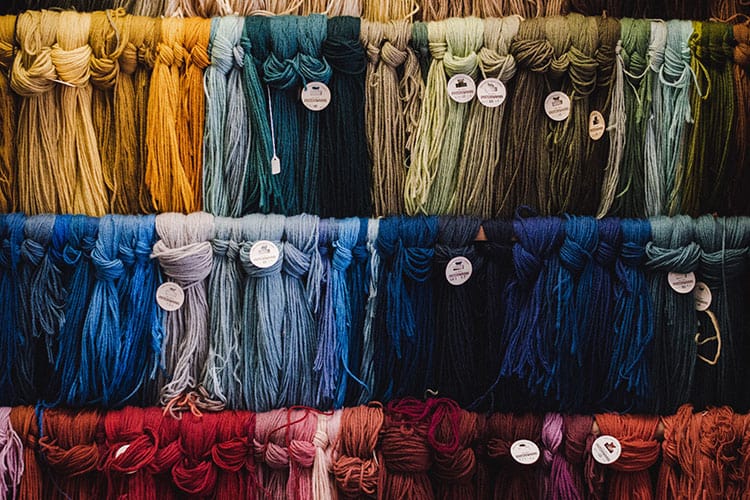
Reading the label on a skein of yarn is a lot like reading a food label when you’re grocery shopping. The yarn label should tell you everything you’ll need to know about the yarn and give you a good idea if it’s right for your project.
Most standard yarn labels should include the following information:
Length/Weight – Every yarn ball or skein you purchase should have some measurement of how much yarn is in that individual lot. Yarn is typically measured by length, weight or by both. Length is measured in yards or meters. Yarn weight is generally measured in ounces or grams. Review your pattern and be sure to purchase enough yarn for your project.
Fiber Content – Every skein of yarn will also tell you the type of fibers the yarn is made out of (see more below about the different types of yarn fibers). If the yarn contains more than one type of fiber, it will include a percentage of make-up for each fiber in the blend.
Recommended Hook Size – Most commercially manufactured yarns will include a recommendation for the size of the hook and the gauge. This information can be helpful, especially if you’re substituting a different yarn than the one included in your pattern. If the recommended hook size is the same for your pattern as it is for the yarn, the yarn may be a good substitute.
Care Instructions – Every yarn label should tell you exactly how to care for the finished garment. Sometimes care instructions are listed by symbols rather than text, indicating if the yarn can be washed in a machine or by hand, the preferred water temperature, and the proper way to dry the finished project.
Dye Lot – Finally, every skein of yarn should include a dye lot. Commercial and handcrafted yarns are dyed in batches. Subtle variations in the color and characteristics of the dye can mean that each batch is slightly different than the previous batch. Purchasing yarns from two different dye lots could mean parts of your project have slightly different coloring than others (darker, lighter, different tone, etc.) Be sure you look at the dye lots when choosing yarn for crochet and choose yarns from the same dye lot.
Choosing Yarn for Crochet

There are many different ways to choose yarns. For beginners, it’s best to select a yarn either by the weight/thickness or by the fiber type.
Choosing Yarn By Weight
Every commercially manufactured yarn should include a standard yarn weight, or thickness rating. A yarn’s weight directly correlates with the size of the crochet hook that works best to create a project with that yarn. Yarn weights are numbered #0 to #7, with smaller numbers being the thinnest and larger numbers the heaviest weight yarns.
Lace (#0) and Super Fine (#1) are delicate yarns or crochet threads. Crochet threads and these super fine weight yarns are often made into lacy items like doilies, shawls, and scarves. Superfine weight (#1) is sometimes called fingering weight yarn. Often these weight yarns are made into socks, scarves or baby clothing. They recommended for US hook sizes B-1 to E-4
Sport Weight (#2), Light Weight (#3) and Medium/Worsted Weight (#4) yarns are popular for beginning crocheters. These yarns are versatile, approachable, and can be used with US hook sizes ranging from E-4 to I-9 depending on the project. Sport weight is often called baby weight yarn since it’s popular for baby clothing, blankets, and accessories. If you are practicing new stitches or just getting started learning to crochet, choose a medium weight (#4) yarn. It’s a good balance, not too thin that it’s difficult to work with, but bulky enough that projects will work up quickly.
Bulky (#5), Super Bulky (#6) and Jumbo (#7) are the thickest yarns available. They are typically crocheted with US hook sizes K-10 or larger. Jumbo yarns are frequently used with finger crochet (no hook). Bulky yarns have become very popular in recent years because the projects work up very quickly. Patterns for blankets, hats, scarves and other projects created in a few hours or a weekend will likely be made with a super bulky yarn. Some beginner crocheters may find learning to crochet with a bulky yarn more difficult. Others may find the large stitches help you learn where to place the hook and how to correct mistakes more easily.
Thickness or weight can often impact the texture of yarn. This can make a big difference in how difficult or easy it is to insert the crochet hook into the project, draw up yarn, and then pull it through to form new loops. When you purchase yarn, feel the texture of the skein and the texture of an individual strand of yarn. Try to get a sense of how that weight yarn will work up on a crochet hook before you buy.
Choosing Yarn By Fiber Type
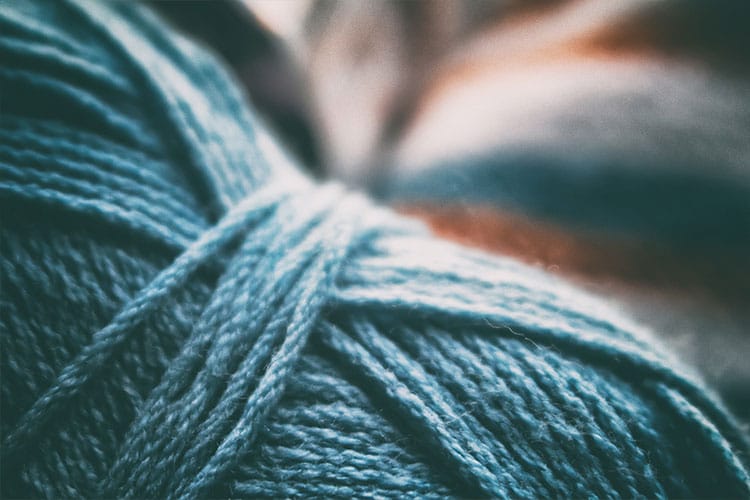
Another way to select yarn for crochet is by the material the yarn is made out of. There are hundreds of different types of yarn, made out of all different types of materials.
Yarns can come in either natural or synthetic fibers. Natural fibers are created from either animal or plant materials. Synthetic fibers are created from man-made materials. Yarns can also be a blend of different fibers (e.g. cotton and polyester blend) which can add different characteristics to your project. There are pros and cons to using each different type of fiber. Learning those can help you select the best fiber type for your project.
Natural Fibers
These are a few of the common natural animal and plant fibers popular in crochet:
Wool – Sheep’s wool is one of the most common yarn fibers on the market. It’s great for all different types of projects, it’s affordable and easy to use for all levels of crochet experience. Many people choose to make winter garments (hats, sweaters, mittens) from wool because it is warm and durable. Wool can be dyed in lots of different colors and can come in luxury forms like merino, made from the wool of merino sheep, native to Spain. Downsides of wool: it must be cared for properly or it can shrink or pill.
Alpaca – The alpaca is a mountain animal domesticated originally in South America. The alpaca fiber has been made into yarns for thousands of years by indigenous people. Living high in the mountains, you can imagine that alpaca yarn is famous for its warmth and resistance to weather. It’s more water repellant than wool but soft against the skin. It’s also hypoallergenic, making it great for baby accessories. Downsides of alpaca: It’s more expensive than wool and finished projects can stretch over time. Look for alpaca ‘blends’ that contain wool or cotton to help keep the tension over time.
Mohair – Mohair is produced from the downy inner layer of hair of the Angora goat (not to be confused with the Angora rabbit!) Mohair has a unique glossy appearance and is often used in sweaters and hats. It’s also well known for being one of the warmest fibers. Mohair may be better for experienced crocheters because the fibers can be fragile. Too much tension and the yarn can break. Other downsides of mohair: Some people experience skin irritation from mohair, it’s more expensive than wool, and is best dry clean only.
Cotton – The most common plant-based fiber, cotton is inexpensive and easy to use for all types of crochet projects. Of the natural fibers, cotton is also one of the easiest to maintain as it’s machine washable and holds its shape well over time. Crochet projects that use cotton include household projects and summer garments and accessories. Downsides of cotton: some find cotton to be stiff and the fibers can split apart when you’re inserting your crochet hook into the project.
Bamboo – Another plant fiber that has joined the market in recent years is bamboo. Bamboo yarn is crafted by mechanically combing the fibers out of the walls of the bamboo plant. While more expensive than cotton, it’s more environmentally friendly than other yarns. Bamboo is known to be very soft and has UV protective qualities, making it popular for baby clothes and accessories. Downsides: more expensive than cotton, highly absorbent (can wick up odors or stains), loses some durability especially when wet, so bamboo projects need to be hand washed.
Synthetic Fibers
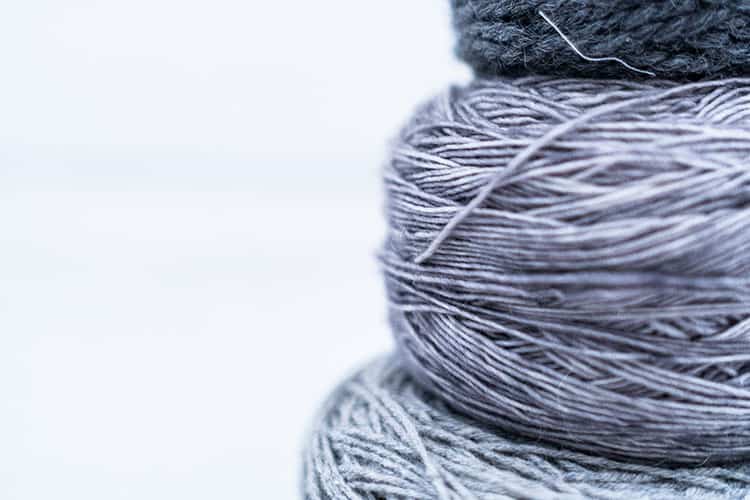
In contrast to animal or plant fibers, synthetic fibers are created using human-made materials. Some of these materials have been around for more than 50 years, yet they remain popular in crochet projects because of their affordability and durability as compared to natural fibers.
Acrylic – Acrylic yarn has stood the test of time as the most widely used synthetic yarn both in knitting and crochet. It’s a manufactured fiber made from the chemical “acrylonitrile.” Acrylic yarns are available from all major brands and are mass-produced in thousands of different colors and weights. Acrylic yarn is affordable and lasts longer than many other yarns, even after repeated washings. Downsides: Acrylic yarn has a rougher texture than some of the other fibers listed here. It’s also flammable, so it should not be used for kitchen projects. Finally, the chemical used to make acrylic yarn is a known carcinogen. While that does not mean that acrylic yarns are unsafe, some people may prefer to select a natural fiber instead.
Polyester – While all-polyester yarns have become less popular in recent years, you may often see a percentage of polyester blended into other yarn fibers. Polyester is derived from natural gas and oil products and makes a wrinkle and stain-resistant fabric. When blended with cotton or other natural fibers, it can be very durable and has good moisture-wicking qualities. You’ll commonly find polyester blends in fashion yarns with glitter, faux fur, or metallic threads woven in. Other downsides: Some consider the fossil-fuel-based nature of polyester to be less environmentally friendly than other yarns. Polyester can also be difficult to learn to crochet with as they don’t give a lot of definition to stitches.
Other Things to Consider When Choosing Yarn for Crochet
After yarn weight and the type of fiber, there are a few other factors that you may choose to consider when purchasing yarn for an upcoming crochet project.
Choosing Yarn By Care Instructions
Alluded to above, different fibers need to be cared for differently. When purchasing yarn, you may want to consider how often the project will need to be laundered. For dishtowels or garments, you may choose a machine washable yarn with good durability. For projects that need to be laundered less often (hats, blankets, etc.) it may be okay to choose a dry clean or hand-wash only yarn.
It’s important to consider this when crocheting gifts for other people. There’s nothing worse than finding out that dry-clean only blanket that took you weeks to make, ended up shrinking in the dryer of a well-meaning family member who didn’t know better. Always make sure when you purchase yarn that you save the care instructions listed on the skein in a safe place. If you give the finished project as a gift, attach a small card with the care instructions.
Choosing Yarn By Color
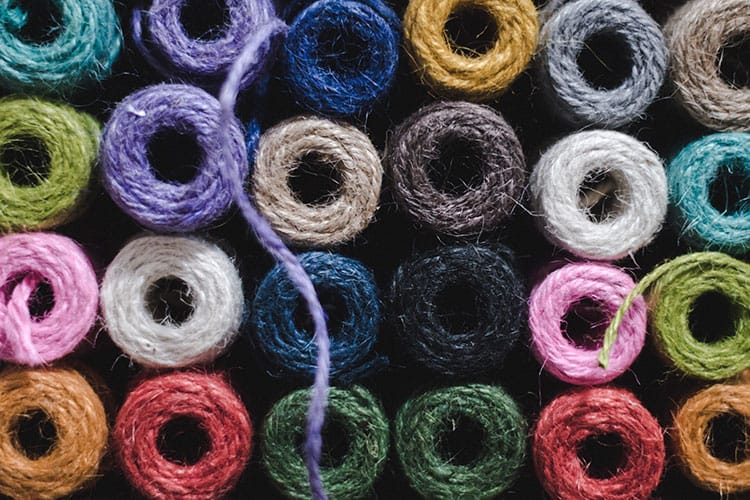
Color is one of the first features we tend to gravitate towards when we purchase yarn. Finding the most attractive color scheme for your project or the perfect shade to match your home furnishings is part of the fun when buying yarn. Choosing yarns in your favorite colors makes projects more fun and motivating to finish. Just be sure that when you’ve found the perfect color yarn, that it’s also the correct weight and fiber type to match your crochet pattern. One final note about color, whenever possible, beginners should choose lighter color yarns. They are easier to crochet than darker colors as they have better contrast between the individual stitches as you’re learning to insert the hook into the correct place of the previous row.
Choosing Yarn By Price
While we don’t often like to think about money when planning craft projects, the reality is that not all yarns are priced the same. When you’re just getting started with crochet projects, choosing yarns that are mid-priced or more affordable is better than going straight for expensive specialty yarns. While it can be tempting to choose high-end, wool, cotton and acrylic tend to be better choices for the beginning pocketbook.
There’s also nothing to say that you can’t crochet a blanket from the most expensive skeins. Yet most crocheters tend to use more affordable yarns for larger projects (blankets, sweaters, and afghans) and save expensive specialty yarns for smaller projects (scarves, hats, mittens).
Choosing Yarn By Yardage
Circling back to choosing yarn by price, you always want to get the most yarn for the best value. Occasionally you’ll have the option to choose between the same yarn sold in two different yardages at two different prices. By buying in bulk, you’re able to get more yarn at a slight discount over the smaller skein. Or you may find two different types of yarn for the same exact price but because you examined the yardage, you find that one has more yardage for the same price. Knowing the price per yard or price per gram of the yarn you are purchasing can help you make a better-informed decision about the best value.
Choosing Yarn For Sensitive Skin or Allergies
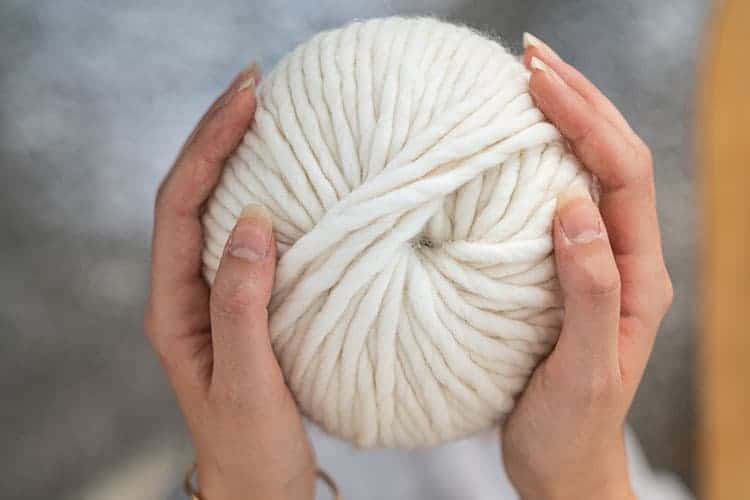
When selecting yarns for garments, you may want to consider the skin type and allergies of the person who will use the finished project. Animal fibers like wool and alpaca can be uncomfortable on sensitive skin or can cause an allergic reaction in some people. For those with allergy concerns, look for hypo-allergenic fibers like bamboo or baby yarns marked specifically for sensitive skin.
Choosing Yarn By Ethics
A growing number of crocheters are choosing yarn based on their personal values and ethics about sustainability and animal welfare. Yarns now come in organic, vegan, and environmentally sustainable options to help keep your crafting aligned with your personal beliefs. Others may choose to spend their crafting budget with a local yarn shop or artisan spinner that also supports their values and ethics. By carefully reading labels and choosing manufacturers you can ensure that you’re just as proud of your yarn choices as you are your finished crochet project.
A Final Note About Yarn Substitutions
Every crocheter goes through a failed yarn substitution at least once or twice. It’s a painful process when you start out with the best intentions, only to find that the new yarn you chose was not well-suited for the pattern. Too loose, too tight, too droopy. These are all things that can happen when you substitute the wrong yarn. That being said, there are some ways to make sure your substitutions do end up with a good outcome. That includes not compromising when it comes to identifying a yarn with the same weight and trying your best to find similar textures and fiber characteristics.
To start, always identify the weight of the yarn using the number found on the skein and the number in your pattern. It can’t be stressed enough that in order to make a good yarn substitution, you must choose yarn in the same weight class. Lighter or heavier weight yarns are guaranteed to cause problems without some detailed planning of crochet hook sizes and pattern changes.
Once you have a similar weight yarn, then try to find a yarn with a similar texture and fiber characteristics. For example, if your sweater pattern calls for merino wool but it’s a bit pricey for your budget, it’s better to look for a synthetic yarn or a wool alternative that’s closer to merino rather than make the pattern out of something like cotton. Wool and cotton do not have the same texture, warmth or density. You’ll likely be disappointed with the outcome because the yarns don’t have equivalent characteristics.
Finally, if you intend to substitute yarns, you should always begin with a gauge swatch. Different yarns require different gauges and you may need to substitute a slightly larger or slightly smaller crochet hook to get the right gauge. Try several different swatches until you are comfortable that the swatch exactly matches what was recommended in the original pattern.
Related Questions

Can you use the same yarn for knitting and crocheting? Yes. Yarns sold in yarn shops and craft stores can be used for both knitting and crochet. However, there are some types of yarns that work better in one craft or the other. For crochet, it’s important to look for yarns with fibers that are tight together. Otherwise, as you push the crochet hook into the project to draw up a loop, you’re at risk of splitting the yarn thread. Likewise, very fine fibers like crochet thread may not be suitable for projects using a knitting needle.
Always review the label around the skein of yarn before you purchase it for guidance on what size crochet hook or knitting needle the yarn is well-suited for.
Do you have to purchase all the yarn for a crochet project at once? In general, if you know what you need for a project, it’s best to purchase everything at once. Especially for larger projects like blankets and afghans that require lots of skeins of yarn. While commercial dying processes have become more mechanized and have fewer variations in it, there is some benefit to purchasing all the yarn you might need for a project before you begin the project. If you would happen to run out of yarn and need to go back, you may find that the dye lot is now different and the new yarn is slightly darker, lighter or a different tone than what you started your project with.
Unfortunately, what’s more likely to happen because of the huge variety of yarns on the market now, is that your yarn shop no longer carries the skeins you purchased before. In that case, you’re at risk of having to search online forums for others who might have some of the same yarn in their stash. To avoid the risk, it’s best to purchase all the yarn for a crochet project before you begin the project.

